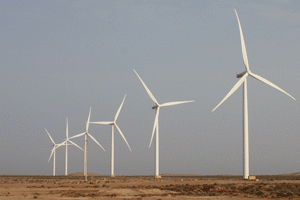Because of the intermittent nature of wind and its dependence on weather conditions, wind power output cannot be guaranteed at any particular time. In addition to dispatching-challenges requiring alternative reserve margins, wind power generates various disturbances in a grid network. Such disturbances include ‘flickers’, short frequency variations, harmonics and reactive power which requires compensation. This constitutes a barrier for the large-scale integration of wind power into grids.
The use of HVDC technology tends to stabilize power grids by sheltering them from interferences related to wind energy generation. When an HVDC link is embedded in the existing Alternating Current (AC) grid network, it allows the transmitted power to be ‘dialed up’ and even modulated in response to inter-area power oscillations. The HVDC line dramatically improves power flow controllability in the interconnected networks by providing greater stability and system security. In a cascading AC fault, the HVDC interconnection acts as a firewall and stops the propagation. Hence, the transfer of large quantities of wind energy from the Saharan coast through Sahara Wind's HVDC line will help stabilize the grid network and contribute to increase wind energy generation on both ends.
 Environmental benefits are significant since a wind energy source is used to stabilize additional amounts of renewable energies at the extreme points of a grid network. When considering synergies that could be derived through wind energy storage technologies, then fossil fuel back-ups may be redundant. An economically viable carbon-free energy transition would, in this case, be validated.
Environmental benefits are significant since a wind energy source is used to stabilize additional amounts of renewable energies at the extreme points of a grid network. When considering synergies that could be derived through wind energy storage technologies, then fossil fuel back-ups may be redundant. An economically viable carbon-free energy transition would, in this case, be validated.
Power fluctuations of wind farms occur for short periods of time, such as a few seconds or minutes, and can extend for a couple of hours. The smaller these fluctuations are, the easier they can be handled by other power plants in a grid system in order to meet demand. Fluctuations decrease with increased numbers of turbines in a wider catchment area, as their energy production is never entirely correlated.
Large-scale wind power generation modeling used by central grid operation centers rely on the observation of representative samples for system demand control. These can be made at the scale of a wind farm, at cluster levels or even through individual turbines. The instantaneous productions of these samples are extrapolated to the total feed-in power output of a large supply area with satisfactory results.
Accurate monitoring and forecasting of power inputs from all wind turbines into the grid improves the acceptance of wind power as a reliable, clean energy source. This also increases its market value.
The predictability of renewable energy generation is no greater problem than that of anticipating loads. It will continually improve using satellite weather and remote sensing technologies. Accurate power load monitoring is accessible through smart grids. More flexible through demand response, smart grids provide value to the integration of renewables in a power grid. Traditional base load plants powered by coal, lignite or nuclear fission can hardly expand into a sustainable future electricity supply, as their inertia prevents them from covering fluctuating load demands most appropriately.



